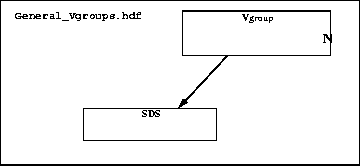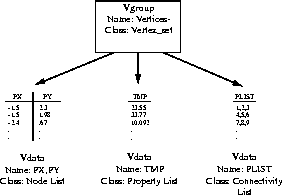EXAMPLE 2. Adding an SDS to a New Vgroup
This example illustrates the use of Vaddtagref/vfadtr to add an HDF data object, an SDS specifically, to a vgroup.In this example, the program first creates the HDF file "General_Vgroups.hdf", then an SDS in the SD interface, and a vgroup in the Vgroup interface. The SDS is named "Test SD" and is a one-dimensional array of type int32 of 10 elements. The vgroup is named "SD Vgroup" and is of class "Common Vgroups". The program then adds the SDS to the vgroup using Vaddtagref/vfadtr. Notice that, when the operations are complete, the program explicitly terminates access to the SDS, the vgroup, the SD interface, and the Vgroup interface before closing the HDF file. Refer to Chapter 3, Scientific Data Sets (SD API) for the discussion of the SD routines used in this example.

